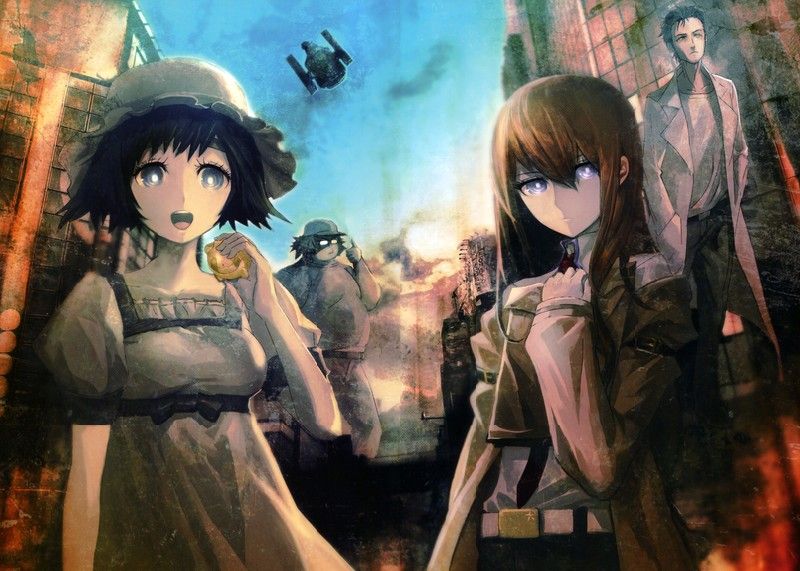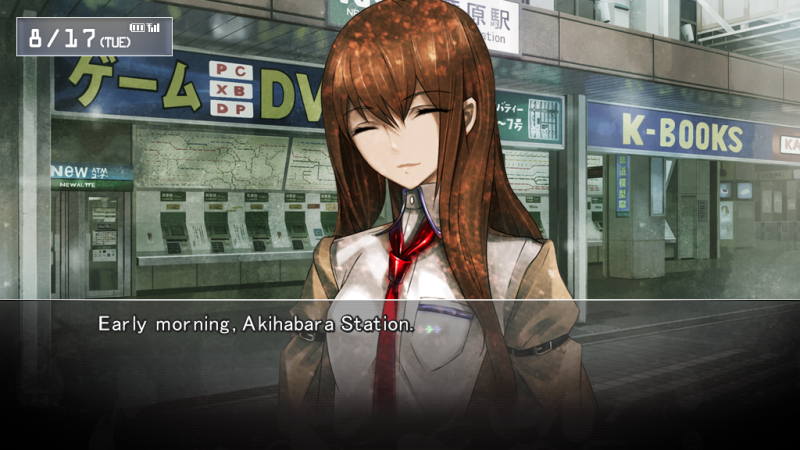Steins;Gate and Time Travels: No time to die... twice.
When I first saw the Steins;Gate anime, I was struck by the incredibly “slow” atmosphere. The surreal overlay of events immediately captivated me and I wasn't disappointed.

When I first saw the Steins;Gate anime, I was struck by the incredibly “slow” atmosphere. The surreal overlay of events immediately captivated me. I remember it was night, I was alone, unable to sleep, and I was receptive, ready to receive a special message, something different and surprising; and I wasn't disappointed.
Main Characters:
- Rintaro Okabe
A self-proclaimed mad scientist who usually refers to himself as "Kyoma Hououin". He appears to be delusional and paranoid, and is usually on his cell phone railing against the elusive "Organization". - Kurisu Makise
A prodigy neuroscience researcher. - Suzuha Amane
An enigmatic girl who works part-time for the landlord of Rintaro's flat and is on a search for her father in Akihabara. - Mayuri Shiina
A childhood friend of Okabe. - Itaru Hashida
An hacker with experience in both software and hardware technologies. He is also well-versed in things pertaining to otaku culture. - Moeka Kiryu
A shy girl that Okabe bumps into in Akihabara. She is on a search for the IBN 5100 personal computer. [More here] - Time is also a character, probably the most important one.
It is those who possess wisdom who are the greatest fools. History has shown us this. You could say that this is the final warning from God to those who resist.
Rintaro Okabe
A Sci-Fi Thriller
Steins;Gate is a science fiction anime, that has its origins as a Japanese visual novel, a sort of videogame where the graphic side is not highly developed, so there are drawings rather than animations to guide the player. I have played it a couple of times and each time it has been incredibly intense, and there is a definite reason why the intensity of the emotions is so keen: In Steins;Gate the story, the dialogues and the narration are so powerful that you almost forget about the graphics.
Traveling through time
Steins;Gate is different. Totally different, both as a videogame and as an anime. The main theme is time travel. Just by mentioning it, I get excited. But the story isn't just about the characters' time travel; it's substantial and plausible because of the scientific theories of time travel involved, and especially its ethical paradox. It takes place in the Akihabara district of Tokyo between July and August 2010. The scene opens with Rintaro Okabe (or Kyoma Hououin or Okarin as his friends call him) and a friend of his, a strange little girl with eyes filled with something indefinable - Mayuri Shiina. The two are going to the Tokyo Radio Palace to attend a lecture on time travel by Professor Nakabachi. There, Rintaro meets Kurisu Makise, an 18-year-old girl who is already a researcher in America, as well as a gifted and well-known scientist. The two talk; she claims to have met him before; Rintaro does not catch this hint. After the lecture, Rintaro hears a shocking scream from upstairs, goes there, enters a gloomy room and finds Kurisu Makise: the girl lies dead in a pool of blood.
D-Mail
Upset, he runs away, but sends an e-mail to his friend Itaru Hashida, a hacher who has his same passion for futuristic gadgets. Rintaro e-mails Itaru that he's discovered Kurisu dead. Suddenly, all the people around him disappear, and Rintaro finds himself wandering through an empty and silent Tokyo. So, he returns to his research lab and encounters Kurisu Makise again, alive and healthy. Dumbfounded, Rintaro finds that the date of the e-mail sent to his friend is from a week ago, at which point he quickly realizes that the telephone microwave oven he and Itaru are experimenting with may be the first time machine in history capable of sending messages into the past.
In Steins;Gate time travel happens in three ways:
- Via a particle accelerator, in Steins;Gate it is the CERN particle accelerator, which can generate a mini-black hole and allows the time jump to take place.
- Via the telephone microwave, invented by Rintaro and Itaru. It can create the same radiation as a particle accelerator. Because of this, the protagonists' happens to be able to send messages into the past, messages called d-mails, by connecting the microwave to their own phone. In this case, it is not time travel, but a temporal connection, a kind of space-time correlation.
- Through the time machine, actual time travel, with all its consequences.
The universe has a beginning, but no end. — Infinity. Stars, too, have their own beginnings, but their own power results in their destruction. — Finite.
Rintaro Okabe
In Steins;Gate, time is not a only line, it is something like a “patch cord” composed of infinite streams flowing within it, called “Universe Lines”. The concept echoes the idea of Everett's Many Worlds splitting, in fact every time Rintaro comes back from the future and somehow prevents a key event (which I will not reveal), the world in which the first event happened and the second in which that event was prevented split, creating two universe lines. This means that no changes take place in the main line, because it splits into another universe line in which everyone continues to live as if the canceled event never happened, except for Rintaro Okabe, the only one who continues to remember all the space-time shifts because he is the “gate”, referring to the path from one timeline to another. And “Stein”? In an interview with the news portal Dengeki Online in 2009, game writer Naotaka Hayashi said: “There are two origins for stein. The first is that stein comes from Albert Einstein, whose theory of relativity plays a role in the story. The second is that stein is the German word for stone in the phrase Stone of Destiny.”
Scientific theories behind Steins; Gate’s science fiction
Black Hole
General Relativity tells us that matter and energy bend and stretch space. Therefore, the more mass an object has, the more space is stretched and bent around it. When space is stretched, time is also stretched. So a clock near a massive object will tick slower, and a clock near a low-mass object will tick faster. How much mass does a black hole have? Huge. A clock near a black hole would tick very slowly compared to a clock on Earth, so time is "shortened". In practice, the mass of a black hole is so great that it bends time so that it can wrap around itself, creating what physicists call a "closed time curve" in which we would find ourselves on a trajectory through space that begins in the future and ends in the past, creating a natural time machine. The problem is that this would require traveling faster than the speed of light, which is not possible. Here I could talk about quantum entanglement, which theoretically uses a speed faster than light (which is why Einstein didn't like it), which means that if we create a quantum system in which a black hole is an entanglement node, could we get the time machine? Okay, I'll stop :-)
Speed of Light
As mentioned above, traveling at the speed of light is possible in time, but only in the future. Therefore, the world's largest particle accelerator (at CERN) would be able to travel into the future.
String Theory
Born as an attempt to reconcile quantum mechanics and general relativity, strings are actually one-dimensional objects that replace elementary particles. A cosmic string is a string-like fracture as wide as an elementary particle, as long as a galaxy, and endowed with extreme mass. It is this mass that allows the distortion of space-time. If you travel around this distortion at the speed of light, following a curvature around the string, time will slow down until it takes on negative values. Thanks to this concept, it would be possible to travel into the past.
Not only Science fiction
But Steins;Gate is not only a journey into the space-time of the universe, it is also a journey into the inner time of the characters. Rintaro is a shy and lonely 18-year-old boy. He uses an alter ego, Kyoma Hououin, as a mask to protect himself from the world. Kurisu Makise hides a dark and painful past with her father that led her to flee Japan for America. Mayuri has lost touch with reality after the death of her grandmother. And it’s a love story too, because Rintaro and Makise are going to develop an intense and total relationship, something much stronger than loving. And the different dynamics that reflect society and its communication problems will be experienced by all characters (all members of the research lab).
What’s after the Gate?
Steins;Gate goes through timeline after timeline until Rintaro realizes that the value of time lies in how you use it, and that sometimes, when you love, the right thing to do is not to keep your loved one to yourself, but to let her go, until one day, in an unknown time and space, her gaze will surprise you. Once again.

